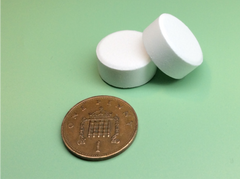How can HOCl be made?
There are three routes to producing HOCl solutions:
- by acidifying a solution of NaOCl (bleach),
- by electrochemical synthesis (“superoxidised water”), and
- by dissolving NaDCC tablets in water.
Production by acidifying a solution of NaOCl
Made by modifying a sodium hypochlorite (bleach) solution by the addition of carefully measured amounts of widely available acids e.g. sulphuric, acetic, phosphoric, to a dilute bleach solution to reduce its pH to a near neutral (pH7). As pH is decreased, HOCl becomes the main form of available chlorine.
This procedure is likely to liberate very toxic chlorine gas unless it is done with accurately calculated and measured amounts of pH adjusting chemicals. Continuous pH monitoring is required.
This means production is best undertaken commercially.
The resultant solution is bulky and expensive to transport.
HOCl production by electrochemical synthesis
Electrochemistry provides a means of producing HOCl in solution, at moderate concentrations, in a consistent and controllable manner.
The process commonly involves the passage of a direct electrical current through a aqueous sodium chloride solution (brine). It was developed and refined by Russian scientists in the 1980s for a vast range of applications.
Reactions can take place either in a variety of electrolysis reactor types. Technological developments continue e.g. Microwave-assisted electrolysis.

HOCl production by dissolving NaDCC in water
A solution of HOCl can be made by simply adding an effervescent NaDCC tablet to water at the dosage level desired. Effervescence speeds up the dissolution and more effectively disperses the reaction products. Within a few minutes the solution is ready to use.
A notable and important property of NaDCC is that not all the chlorine in the molecule is converted to HOCl immediately upon dissolution in water. Some chlorine remains bound to the parent molecule. The balance between bound and free forms of chlorine is stable, but as the free available form (i.e. HOCl) is used up by microbes and/or organic soiling, the balance is corrected by HOCl being released from the bound form.
This special “reserve chlorine” property of NaDCC allows it to be more effective than bleach-derived chlorine particularly when the diluting water is subject to high or variable organic loads. Also it helps HOCl to remain effective over a wider water pH range as tablets make an acidic solution when diluted, which optimises HOCl’s stability.
What is NaDCC?
NADCC or sodium dichloroisocyanurate (C3Cl2N3NaO3) is a colourless, water-soluble, and chemically stable solid.
NaCl2(NCO)3 + 2H20  2HOCl + NaH2(NCO)2
2HOCl + NaH2(NCO)2

NaDCC tablets

NaDCC tablets are freely available under many brand names.
The LD50 * of NaDCC is 700mg/kg, which is equivalent to 49g, or approximately 30 tablets. Inhalation: NOAEC in rats is 2.0mg/m3.
Practical steps to making HOCl from NaDCC tablets in the home.
1. METRIC (millilitres or ml)
Start with one tablet dropped into a clean two litre (2000ml) bottle filled to the top with fresh tap water.
This will provide you with a starting point for further dilutions. Please label it "500ppm HOCl Stock solution", with the date too.
It is important to remember to label all of the dilutions of HOCl as you make them. Always store HOCl solutions out of daylight. Inside a cupboard is fine.
To obtain 200ppm
Take 100ml of the 500ppm stock solution, pour it into a 250ml drinks bottle and fill it to the top with tap water. This will provide you with a 200ppm concentration.
Alternatively, for a larger volume, pour one litre (1000ml) into a two litre bottle and fill to the top with tapwater.
To obtain 100ppm
Pour 200ml of the 500ppm stock solution into a two litre bottle and fill with tap water to give a 100ppm concentration
To obtain 60ppm
Pour out 30ml, or two UK tablespoons, of the 500ppm stock solution into an empty 250ml bottle and then fill it up to full with fresh tap water. You now have a 60ppm HOCl concentration.
HOCl Dilution Table

* Median lethal dose - In toxicology, the median lethal dose, LD₅₀, LC₅₀ or LCt₅₀ is a toxic unit that measures the lethal dose of a toxin, radiation, or pathogen. The value of LD₅₀ for a substance is the dose required to kill half the members of a tested population after a specified test duration.
